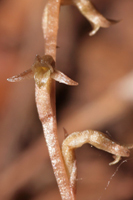Copper Ladies Tresses (Mesadenus lucayanus)
Part of the Florida's Native and Naturalized Orchids Website
Classification:Kingdom: Plantae - Plants
Subkingdom: Tracheobionta - Vascular Plants
Superdivision: Spermatophyta - Seed plants
Division: Magnoliophyta - Flowering plants
Class: Liliopsida - Monocotyledons
Subclass: Liliidae - Lily/related subclass
Order: Orchidales - Orchid order
Family: Orchidaceae - Orchid Family
Subfamily: Spiranthoideae - Spiranthoids
Tribe: Cranichideae - Cranichids
Subtribe: Spiranthinae - Spiranthines
|
Distribution Map: |
Description: Synonyms: Ibidium lucayanum, Spiranthes polyantha, Mesadenus polyanthus, Spiranthes lucayana Summary: plant a terrestrial deciduous herb, leaves ovoid, borne in a basal rosette flat to the ground. Flower spike brown-copper color with numerous very small (5 mm), greenish-copper flowers. Dorsal sepal and lateral petals fused, arched backward. Lateral sepals and lips also arched, giving the appearance of a four-part flower. Common Name: Copper Ladies Tresses Habitat: Semi-dry mixed hardwood-conifer woodlands, quite often in association with rocky outcroppings. Flowering season: January through March (peaking in February) |
Images:
Description:
This is an extremely rare (listed endangered in our state) and inconspicuous species of orchid, having been found in only a few counties scattered around the state. It is likely that there are other populations, but they are so difficult to see even when one knows exactly where to look.
Their small, basal rosettes of leaves are probably the easiest thing to see, with leaves reaching three inches in length at times. These are almost always associated with rocky limestone outcroppings, which are not very common in our state. Often growing in small pockets of humus in the rock, these plants could almost be classified as lithophytes at times. One particularly robust colony of these plants is associated with an old abandoned phosphate quarry that was last active nearly a century ago. A new canopy of small oaks and Eastern Red Cedars have since recolonized the area, forming a lovely canopy over the flowering plants below.
In the cool of winter, the flower spikes emerge from the centers of the leafy rosettes, while the leaves themselves begin to fade. It is often the case that the leaves are completely absent at the time of flowering, but they will sometimes persist.
The small green-copper flowers are borne on very long, slender stalks in the early spring. The lateral sepals spread widely, while the lip and dorsal portion (formed out of the dorsal sepal and two lateral petals) spread with roughly the same curvature, making the flowers appear to be composed of just four parts.
After the flower spikes wilt, a new rosette of leaves will emerge in early summer to persist through the fall and winter until the next flowering of this plant.
Those who have been witness to this species in the wild will count themselves among the very few and very fortunate.
Copyright © 2009-2020 Prem Subrahmanyam, All Rights Reserved.
No Text or Images from this web site may be used, in whole or in part, without the express permission of the author.
For further information, see the Terms of Use page.










